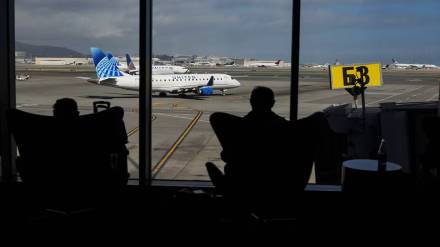U.S. airlines scrambled on Thursday to rejig schedules and field calls from anxious customers after the Trump administration ordered flight reductions at major airports due to a shortage of air traffic controllers during the longest government shutdown in history.
The cuts, set to begin on Friday, were expected to hit hundreds of thousands of travelers with little notice. Aviation analytics firm Cirium estimated the reductions would cancel up to 1,800 flights and cut 268,000 airline seats a day in the U.S. International flights are not affected.
The timing, during a period of low travel demand, was making it easier for carriers to rebook passengers by cutting flight frequencies on some routes and using bigger planes. Analysts said the impact on airline earnings was likely to be modest as long as the shutdown ends before the peak Thanksgiving travel period later this month.
“During the current low season, airlines tend to have lighter load factors, so the ability to accommodate passengers is higher,” said Savanthi Syth, an analyst at Raymond James.
Shares in major U.S. carriers, including Delta Air Lines and United Airlines, closed between 1% and 2% lower on Thursday.
Airlines offer flexibility for changes
In line with the federal directive, Delta announced the cancellation of about 170 U.S. flights on Friday, with fewer expected on Saturday due to lower travel volume. The carrier normally operates 5,000 daily flights globally.
The airline said it plans to cancel flights a day in advance to give customers options well before they head to the airport.
“We’re operating the vast majority of our schedule and intend to keep access to all of the markets we serve, though frequency may be affected,” Delta said.
United said it plans to cut 4% of its flights Friday through Sunday, resulting in less than 200 daily cancellations. The Chicago-based airline operates around 4,500 flights a day.
American Airlines reduced its schedules by 4% across 40 airports, amounting to around 220 flights canceled each day from Friday through Monday. Southwest Airlines will cancel about 120 flights on Friday.
Alaska Airlines has begun canceling a limited number of flights from Friday. The carrier said that most cancellations would affect high-frequency routes, allowing the majority of customers to be re-accommodated with minimal disruption.
Discount carrier Frontier said most of its flights would operate as planned, though in a LinkedIn post its CEO Barry Biffle advised customers traveling to funerals or other critical events over the next 10 days to book backup tickets on different airlines.
All major carriers were offering customers greater flexibility to change or cancel trips.
Using bigger planes
Airlines can lessen the disruption by using bigger aircraft, a strategy they already employ to deal with congestion in New York-area airports.
Still, passengers inundated carriers on social media platforms like X with questions and comments as they tried to clarify their travel plans.
While sales of its “disruption assistance” service have risen steadily since the shutdown began on October 1, travel app Hopper reported an overnight jump of nearly 60% after the government announced flight cuts.
Transportation Secretary Sean Duffy on Wednesday ordered flight cuts to start on Friday at 40 major U.S. airports, including in New York, Los Angeles and Chicago, affecting both commercial and cargo services.
The Federal Aviation Administration will require airlines to cut flights in a phased manner, starting with a 4% reduction on Friday and rising to a full 10% cut by November 14, according to a document seen by Reuters.
Duffy cited safety concerns due to the shutdown, caused by a political stalemate in Congress over funding government operations.
During the closure, 13,000 air traffic controllers and 50,000 security screeners have been forced to work without pay.
Absenteeism has risen to 30% or more at some airports as the workers turn to second jobs to feed their families or are unable to afford childcare.
Even before the shutdown, the FAA was already short about 3,500 air traffic controllers, and many were working mandatory overtime and six-day weeks. Airlines have estimated that at least 3.2 million travelers have been delayed during the shutdown.
Stress for passengers
Following a dip in corporate and leisure bookings in the first half of the year, U.S. airlines had projected a period of steady demand this quarter. Yet, even as reduced capacity is expected to drive up airfares, the uncertainty caused by the shutdown may depress consumer travel spending.
Passenger traffic declined in the first week of November from a year ago after rising in October, data from the U.S. Transportation Security Administration showed.
Airlines for America CEO Chris Sununu urged customers to “stick with their current travel plans” amid a drop in bookings. But even before the new flight cuts went into effect, customers said flight delays and cancellations were causing misery.
Delaware-based Grace Logeman, 40, drove two hours on Thursday to Newark, New Jersey for a Frontier flight to Atlanta that was delayed by three hours. The delay caused her to miss a connecting flight to the Dominican Republic for her sister’s birthday.
“I’m devastated,” Logeman said while on hold with the airline’s customer service line. “As far as the ongoing shutdown…it’s hurting me. I’m the one sitting here now.”
